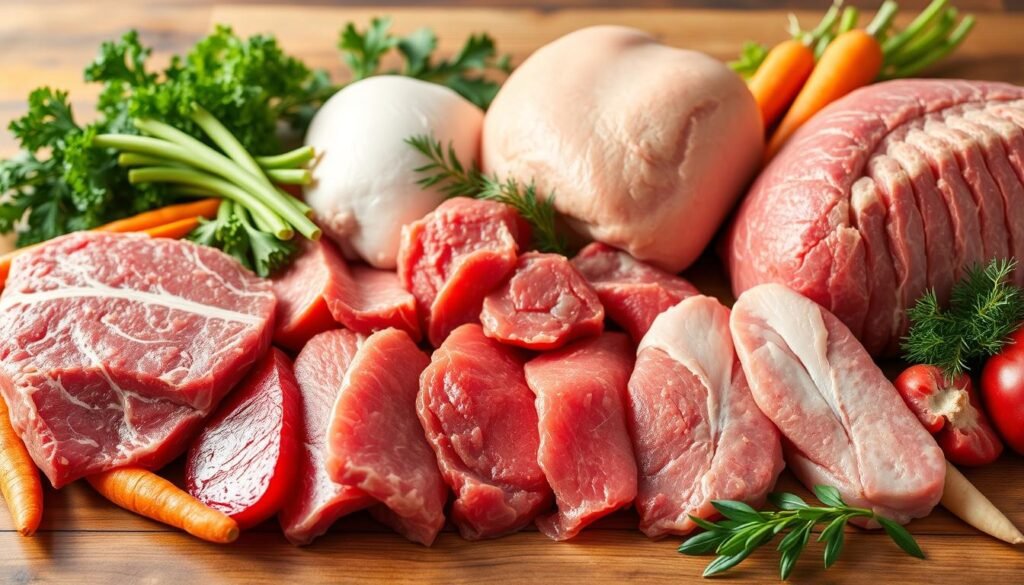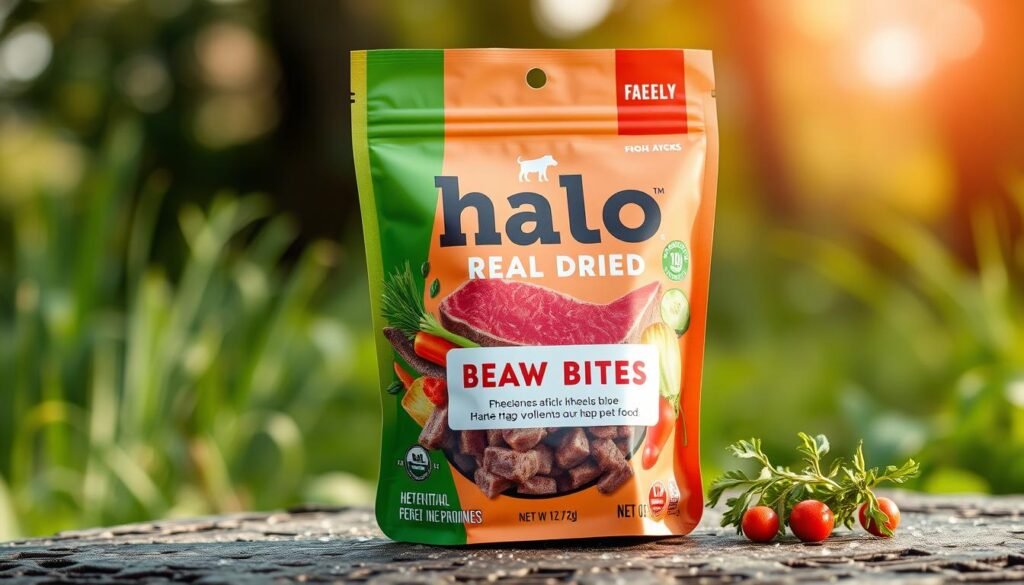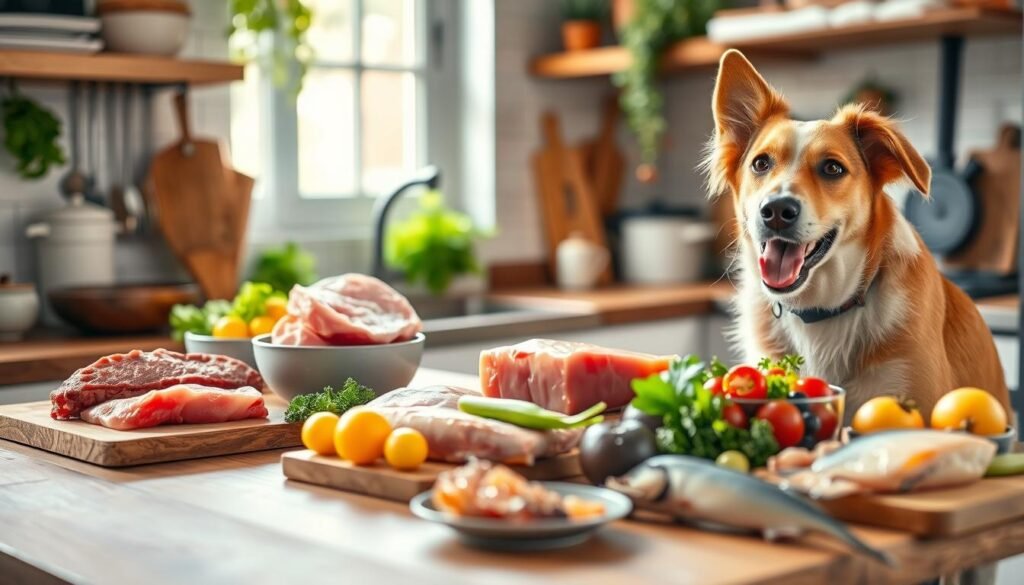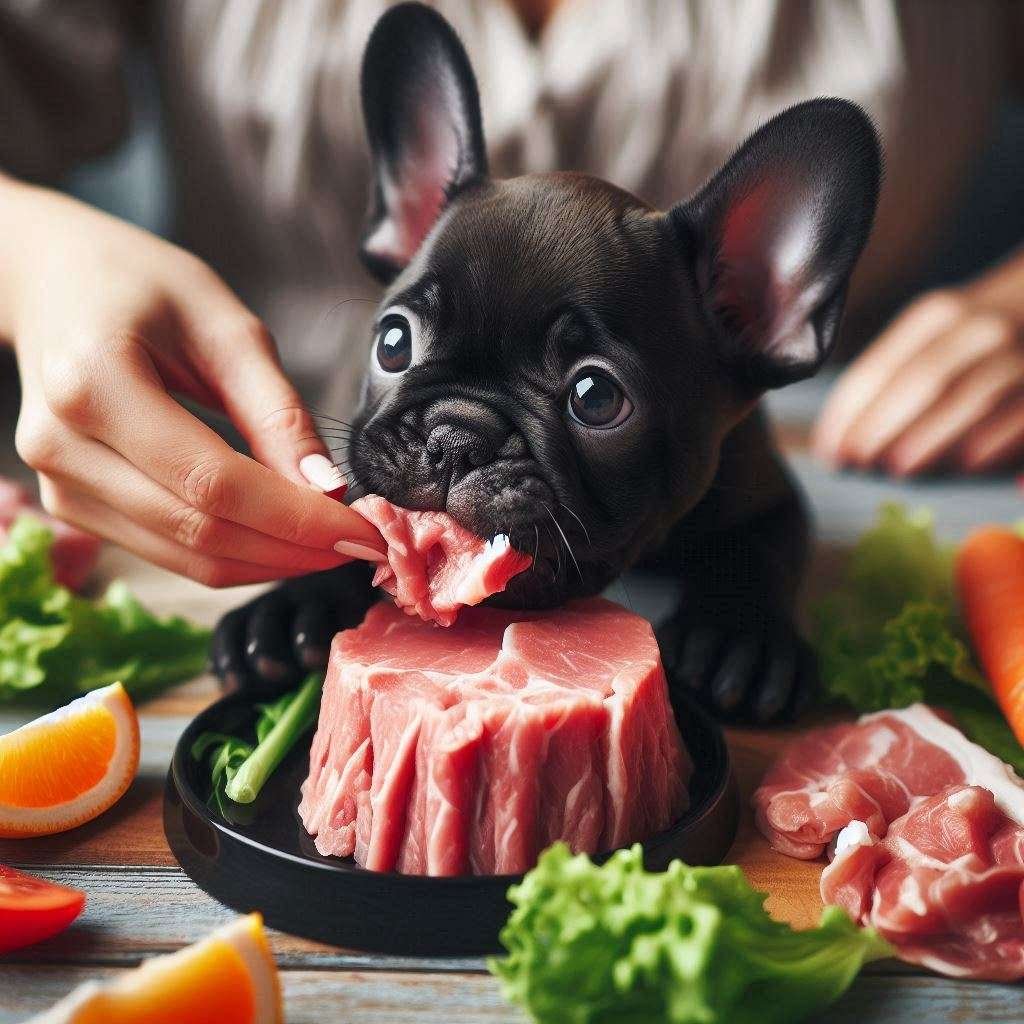What raw meat is best for dogs? with raw dog food diets are becoming more popular for dogs. They aim to give dogs a diet similar to their ancestors. This can improve digestion, skin health, and reduce allergies. But, it’s important to know the risks and how to safely start this diet.
In this guide, we’ll look at the best raw meats for dogs. We’ll cover their nutritional values and how to add them to your dog’s meals. This article is for both new and experienced raw feeders. It aims to help you make the best choices for your dog’s diet.

Key Takeaways
- A raw dog food diet can provide numerous health benefits, but it also carries potential risks that must be carefully managed.
- The best raw meats for dogs include turkey, beef, and chicken, but it’s essential to ensure they are sourced from high-quality, reputable suppliers.
- Proper food handling and preparation techniques are crucial when transitioning your dog to a raw diet to minimize the risk of foodborne illnesses.
- Balancing the nutritional profile of a raw diet is key to ensuring your dog receives all the essential vitamins, minerals, and macronutrients they need.
- Gradual introduction and close monitoring for digestive issues are important steps when transitioning your dog to a raw food diet.
Introduction to Raw Dog Food Diets
The raw dog food diet is becoming more popular. Pet owners like it because it’s seen as more natural and ancestral. It’s based on the idea that dogs should eat like their wolf ancestors – raw meat, bones, and organs.
The Ancestral Diet Compared to Dry Kibble
Dry kibble often has a lot of carbs. But the raw diet is like what wolves eat. It’s thought to give dogs better nutrients and fit their natural diet better.
The Benefits of a Raw Diet
People say the raw diet has many benefits. It can make a dog’s stool firmer, improve digestion, and make their skin and coat healthier. It might also help with allergies and weight.
The Downside of a Raw Dog Food Diet
But, there are risks too. The biggest worry is bacteria like Salmonella or Listeria. These can make both dogs and their owners sick if the meat isn’t handled right.
Before switching to a raw diet, pet owners should think about the risks. They should talk to a vet. Making sure the food is safe and balanced is key for a dog’s health.
How to Choose the Best Raw Dog Food
Choosing the right raw dog food is key for your dog’s health. Look at the ingredients, nutrients, and the brand’s reputation. These factors are crucial for your dog’s well-being.
First, focus on the protein source. Choose high-quality meats like turkey, chicken, beef, or lamb. These are vital for your dog’s growth. Avoid foods with grains, as they can upset your dog’s natural diet.
- Look for a raw dog food with a protein content between 14-19%.
- Ensure that heart meat makes up 10-15% of the total diet, and organ meats account for 5-10%.
- The calcium content in a meal containing bone should be in the range of 0.75 to 1.5%.
Also, consider the fat-to-protein ratio. The fat content should be around 15% or lower. This helps keep your dog at a healthy weight and gives them the energy they need.
Remember, there are safety risks with raw dog food, like bacterial contamination. Commercial raw dog food brands often have better safety measures than homemade diets.
“Over 7 years, a Helsinki University study on cross-contamination in raw dog food discovered only two potential cases of pathogen transmission across 13,000 households.”
By keeping these points in mind, you can choose the best raw dog food. This will help keep your dog healthy and happy.
What Raw Meat Is Best for Dogs: Top Picks
Choosing the right raw meat for your dog’s diet is crucial. The Dog Food Advisor has picked the best raw dog food options. These choices highlight the top raw meats for dogs.
We Feed Raw Turkey Patty
We Feed Raw’s Turkey Patty is a favorite among dog owners. It’s made from hormone-free, antibiotic-free turkey. This recipe is packed with nutrients to keep your dog healthy.
It includes raw bones, organs, and veggies. This mix gives your pup all the essential nutrients they need.
Open Farm Grass-Fed Beef Recipe
The Open Farm Grass-Fed Beef Recipe is great for dogs who love red meat. It’s made from 100% grass-fed, humanely raised beef. This provides natural protein and amino acids.
It also has superfoods like organic kelp and mixed tocopherols. These add extra nutritional value to the raw dog food.
Dr. Marty Nature’s Blend Essential Wellness
Dr. Marty’s Nature’s Blend Essential Wellness is a complete raw dog food. It has a mix of premium proteins like beef, turkey, and salmon. This blend is designed to match a dog’s natural diet.
It includes fruits and veggies to boost your dog’s health. This ensures your dog gets a balanced and complete nutrition.
When picking raw meat for your dog, look at the protein source and fat-to-protein ratio. Also, check for essential vitamins and minerals. We Feed Raw, Open Farm, and Dr. Marty’s are top choices. They offer balanced and nutritious raw diets for dogs.
Halo Freeze-Dried Raw Meal Bites Beef Recipe
Halo Freeze-Dried Raw Meal Bites Beef Recipe is a top choice for dog food, earning a 5-star rating. It’s made from 99% real meat and organs. This keeps the natural taste and nutrients intact.
The recipe is packed with protein and fat, perfect for active or senior dogs. It supports their energy needs.
The recipe’s dry matter has 43.5% protein, 35.9% fat, and 12.6% carbohydrates. It’s mainly beef, with added beef heart, liver, lung, kidney, tripe, herring oil, and amino acids.
It has 44% protein, 36% fat, and 13% carbohydrates on a dry matter basis. The fat-to-protein ratio is about 58%.
Halo’s Raw Meal Bites Dog Food range has two recipes, rated 4 to 5 stars. The average rating is 4.5 stars. The protein content is 49%, fat is 27%, and carbs are 16%.
Halo Dog Food Advisor reviews various Halo products, including canned, dry, and grain-free options. The Freeze-Dried Raw Meal Bites Grain-Free Dog Food is rated 4.5 stars and is highly recommended.

“Halo Freeze-Dried Raw Meal Bites Beef Recipe is a top-notch raw dog food option that delivers high-quality protein and nutrients to support your pup’s overall health and well-being.”
Raw Dog Food Safety and Handling Tips
Feeding your dog a raw diet can be very beneficial. But, it’s important to handle and prepare the raw meat safely. Here are some key tips to avoid bacterial contamination:
- Store raw meat, poultry, and seafood separately from other food items to prevent cross-contamination.
- Use raw ground meats, poultry, seafood, and variety meats within 1-2 days of refrigeration, and frozen raw pet food within 7 days of thawing in the fridge.
- Thaw frozen raw pet food in the refrigerator, maintaining a constant temperature of 40ºF or lower to inhibit bacteria growth.
- Wipe your dog’s beard after eating to prevent the spread of bacteria, and wash your hands thoroughly with soap and warm water for at least 20 seconds after handling raw pet food.
A study by the FDA Center for Veterinary Medicine found that raw pet food is more likely to have harmful bacteria. This includes Salmonella and Listeria monocytogenes. To reduce these risks, clean and disinfect surfaces that touch raw pet food. Also, check out FDA resources for more on safe handling.
By following these raw dog food safety and handling tips, you can enjoy the benefits of a raw dog food diet. This way, you keep your dog healthy and happy.
“Proper precautions can help ensure the safety of both your dog and your household when feeding a raw dog food diet.”
Transitioning Your Dog to a Raw Diet
Starting your dog on a raw diet should be done slowly. This lets their stomach get used to it. Moving from kibble or canned food to raw takes time. But with patience and watching your dog closely, they can enjoy this natural eating style.
Gradual Introduction
Start by adding a little raw food to their usual diet. Slowly increase the amount over weeks. This slow start helps avoid upset stomachs, like diarrhea or vomiting. Most puppies, young, and healthy dogs do well with a quick switch. But older dogs or those with sensitive stomachs might need more time.
Monitoring for Digestive Issues
Watch your dog closely as they adjust. Look at their poop, energy, and overall health. Older dogs might need probiotics and digestive enzymes to help with the change. If they have ongoing stomach problems, slow down the transition to make it easier.
“When switching from kibble to raw, it is suggested to offer one meal of raw food followed by one meal of kibble, gradually reducing the number of kibble meals.”
Being patient and flexible is key when switching to a raw diet. Every dog is different, and how they adjust varies. By following these tips and keeping an eye on your dog, you can make the switch smoothly and healthily.

Raw Dog Food Brands to Consider
There are many other great raw dog food brands out there. These brands focus on using high-quality, sustainable, and ethically sourced ingredients. They aim to support your dog’s health and well-being.
Smallbatch is one such brand. They make complete and balanced raw food with a mix of meat, veggies, and supplements. Smallbatch is all about responsible sourcing and ensuring their products are safe and nutritious.
Steve’s Real Food is another brand to look at. They follow the BARF system, with 60 to 80% raw meat and 20 to 40% veggies, eggs, and dairy. Steve’s Real Food stresses the importance of clean meal preparation.
Instinct offers a variety of raw dog food, including wild-caught salmon and chicken feet. Their meals are designed to be balanced and complete for your dog.
| Brand | Key Features | Protein and Fat Percentages |
|---|---|---|
| Naturaw | 92% total meat & fish ingredients, responsibly sourced | 17% protein, less than 15% fat |
| Poppy’s Picnic | 75-82% meat ingredients, human-grade | Less than 15% fat |
| Naked Dog | 50% total meat and fish ingredients, low fat | Less than 10% fat |
| Paleo Ridge | 95% total meat & fish ingredients, high-quality | 17% protein, less than 15% fat |
When picking a raw dog food brand, look at the nutrients, ingredient quality, and safety. Choosing a reputable brand helps support your dog’s health and happiness.
The Importance of Balanced Nutrition
Switching your dog to a raw diet means making sure it’s balanced. This includes the right amounts of protein, fat, and carbohydrates. Also, it must have vitamins, minerals, and other nutrients. Talking to a vet or pet nutritionist is key to making sure your dog gets what they need.
Research shows Salmonella is in one-fourth to one-half of raw meat diets. Also, 95% of healthy dog recipes in a study were missing essential nutrients. This shows how important it is to pick and prepare raw dog food carefully.
While Salmonella can be in commercial diets too, the risk is lower. Many raw diets are not balanced and can harm dogs. In fact, many vet groups advise against raw meat diets.
To make sure your dog’s diet is complete, use different protein sources like turkey, beef, and lamb. Adding raw bones, vitamins, minerals, and supplements can also help. These add important nutrients for your dog.
By planning and preparing a balanced raw diet, you can give your dog the best nutrition. A balanced diet is the base for your dog’s health and happiness.
Conclusion
A raw dog food diet can be very good for your dog. It gives them a natural way to eat, unlike dry kibble. Knowing the best meats like chicken, beef, lamb, and fish is key. This helps your dog stay healthy and happy.
Raw food can make your dog’s coat shine, give them more energy, and help their digestion. It also keeps their teeth and gums healthy. But, there are risks like bacteria and not getting enough nutrients. It’s important to choose safe brands and follow safety rules.
Deciding on a raw diet for your dog depends on their needs and your ability to provide a safe diet. You also need to be ready for the risks. Talking to your vet and weighing the good and bad can help you decide if raw food is right for your dog.


